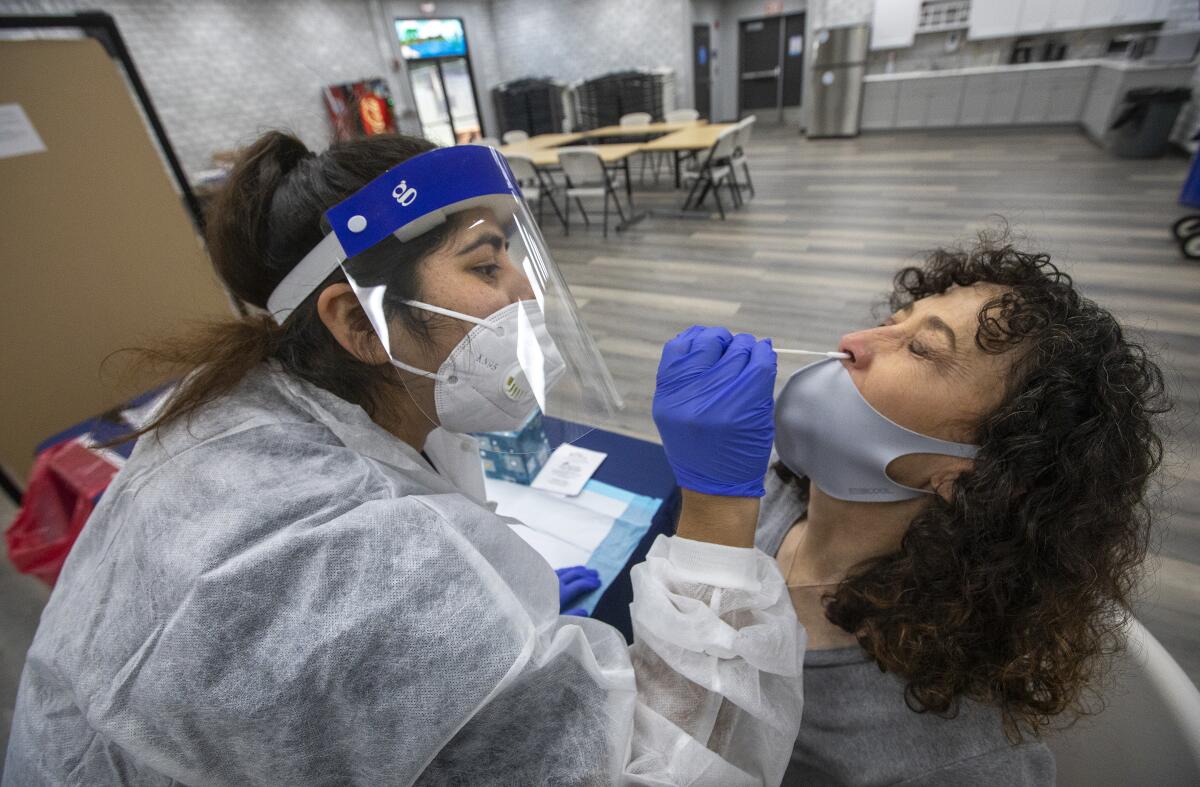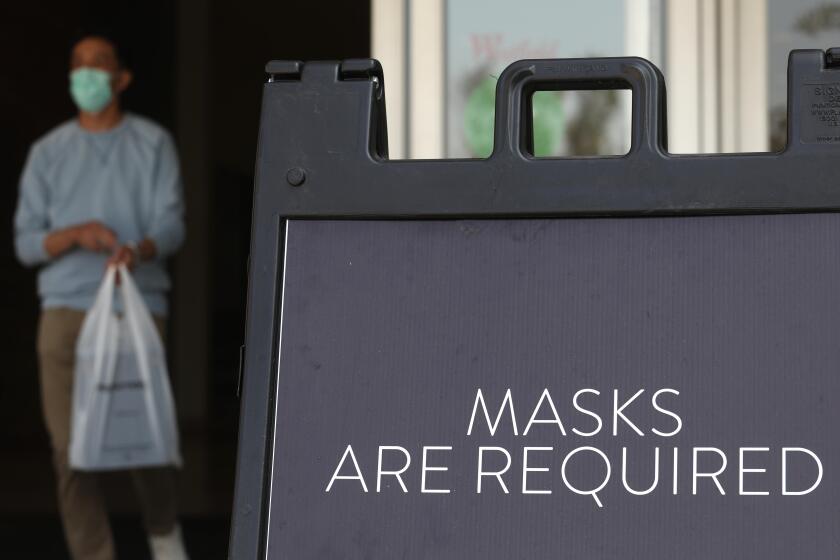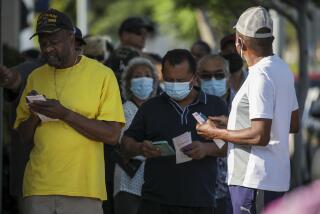COVID-19 death toll nears 17,000 in California

- Share via
While the number of daily COVID-19 deaths has fallen dramatically in California in the last few months, the state’s death toll has become the third-highest in the nation, with nearly 17,000 lives lost.
California ranks behind only New York and Texas in total deaths linked to the coronavirus, with 16,980 as of 5:19 p.m. Monday, according to data compiled by The Times.
When adjusted for population, however, the state is in the middle of the pack nationally. Twenty-six other states have seen more COVID-19 deaths per 100,000 residents than California, including North Dakota, Delaware, Rhode Island, Louisiana and Iowa.
California averaged 57 daily deaths over the last week, a far cry from late July and early August, when the daily death toll at times exceeded 150.
As the number of confirmed coronavirus cases worldwide topped 40 million Monday, California continues to lead the U.S. in case count, with more than 875,000.
But in a sign that the virus may have plateaued in the state, the seven-day average of new cases has dropped below 3,000, according to the latest state data, and the positivity rate — the percentage of those tested who are found to be infected — has been at a relatively low 2.5% for the last two weeks. This is the first time the seven-day average has been fewer than 3,000 since mid-June, according to Times data.
Despite the somewhat promising data points, officials say there are concerning trends. One is the number of COVID-19 patients who are becoming sick enough to be hospitalized. Although the raw number of hospitalizations continues to decline, the rate of decrease has slowed. Over the last 14 days, the state has seen a 4% decrease in hospitalizations — from 2,344 to 2,241 — and a 3% decline in intensive care admissions, from 681 to 660. But in the last week, both those figures have ticked up, Gov. Gavin Newsom said.
“Each and every ICU admission is precious and, obviously, a point of real concern as it relates to quality care and timely care,” he said Monday.
L.A. County’s confirmed infections are doubling every 190.6 days. Hospitalizations have climbed to 751 COVID-19 patients in county medical centers.
As California marks seven months since Newsom’s original stay-at-home order, officials and residents alike find themselves balancing the desire to return to wider normality with the fear that doing too much too quickly could force a fallback to more stringent restrictions on businesses and activities.
Those discussions and debates are taking place as other states contend with new surges in coronavirus infections.
“This is what we anticipated, moving into the colder season, moving into the season where more of us are moving inside, moving into a season where more of us begin to mix and come back ... for the holidays,” Newsom said. “This is an area of obvious and real concern, and that’s why we’re being very sober and, forgive me, stubborn about some industries in the state.”
Of particular concern now are Halloween and Día de los Muertos. Such seasonal celebrations typically entail interactions among numerous households, which public health officials say could worsen the spread of the virus.
In light of the risks, some areas, such as Beverly Hills, have decided to prohibit house-to-house trick-or-treating and car-based “trunk-or-treating” this year. Neither the state nor Los Angeles County has gone that far, though both recommend against such activities.
State health officials have released new guidelines for socializing that prohibit gatherings among more than three households.
Public health officials continue to emphasize that personal responsibility, perhaps more than any policy decision, will chart the future of the pandemic.
L.A. County Public Health Director Barbara Ferrer said Monday that private gatherings — which are allowed on a limited basis — remain a troubling potential source of infections. That’s especially the case for those who may feel a “false sense of security” mingling with people they know and trust, so they don’t adhere to required infection prevention measures such as physical distancing and face coverings.
“We’re not out of the woods at all,” Ferrer said. “We still have widespread community transmission. That means it’s easy for people to get infected when they are gathering, even in small groups.”
L.A. city and county officials are asking residents to be creative in their Halloween celebrations and to avoid trick-or-treating.
More than 288,000 coronavirus infections have been confirmed in L.A. County to date, and almost 6,900 people have died. Ferrer on Monday announced one additional death and 923 new cases but said those numbers are probably affected by a data reporting lag from the weekend.
The county remains in the strictest category of the state’s four-tier reopening system — Tier 1, or purple — because it continues to report more than seven cases per 100,000 residents each day. That means many businesses and public facilities either cannot operate indoors or can do so only at a strictly limited capacity.
Though residents, businesses and even some politicians may be clamoring to lift restrictions and move closer to something resembling normality, Ferrer emphasized that circumstances remain far from that.
“There are ways for us to actually do activities that we love, but we have to do them differently than we’ve done them in the past, and we have to be mindful that we are living through a pandemic,” she said. “There’s nothing normal about this. This is a very dangerous virus that can infect lots of people very rapidly.”
L.A. is one of 10 California counties in the most restrictive reopening tier; the others are San Bernardino, Imperial, Tulare, Monterey, Madera, Sonoma, Mendocino, Glenn and Tehama. Officials recently cautioned that the case rate for San Diego County is trending in the wrong direction — putting it at risk of backsliding into the category too.
“We must bring our numbers down, and the only way to do that is to limit our contact with people outside our households,” Dr. Wilma Wooten, the San Diego County public health officer, said in a statement. “San Diegans who need to be out in public should wear a mask and maintain their distance from people outside their household. Avoid large crowds or gatherings to prevent getting or passing the virus.”
The state will update its tier assignments Tuesday.
With the pandemic still far from over, some have cast their gaze toward a hopeful horizon: the potential that a vaccine could be publicly available before the end of the year.
Gov. Newsom added to concerns about COVID-19 vaccines and said the state will review the safety of any vaccine approved by the Trump administration.
But Newsom on Monday dismissed the idea of a quick rollout, saying that supplies of any vaccine will be limited to start and that deploying doses to millions of residents throughout the state and nation will present significant logistical hurdles that will take time to clear.
“Don’t anticipate or expect that you can go down to the local pharmacy any time in this calendar year and likely get a vaccination,” he said. “We hope that’s the case, but based upon all the evidence, all the data that we have been provided … it is simply unrealistic to expect that. These limited doses will be for a limited number of people, and we don’t anticipate mass availability until 2021.
“The question for all of us: Is that the first quarter, second or third quarter of 2021?”
Times staff writer Esmeralda Bermudez contributed to this report.
More to Read
Sign up for Essential California
The most important California stories and recommendations in your inbox every morning.
You may occasionally receive promotional content from the Los Angeles Times.


















